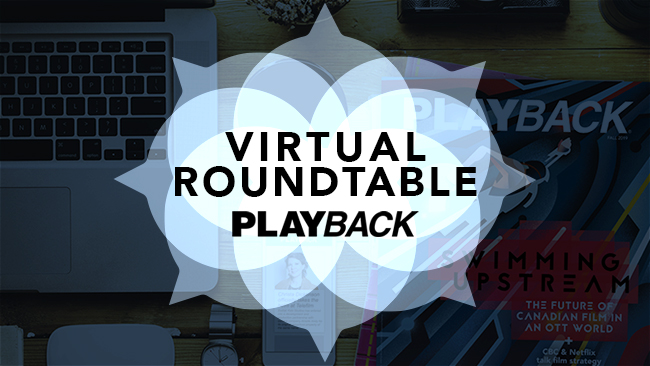Rethinking the production model for a post-COVID world
Virtual roundtable part two: producers discuss ways to future proof against a second or third wave of the pandemic, bracing for unprecedented crew demand when production resumes, and what this all means for the BTLR report. (Unlocked)
The COVID-19 pandemic has upended every aspect of the Canadian production industry over the past four weeks, and looks set to do so for months and potentially years to come. Here, in part two of Playback‘s inaugural virtual roundtable discussion, producers discuss how they are rethinking the entire production model as they look to mitigate against the risk of a second or even third wave of the COVID-19 pandemic, in addition to concerns about high demand for crew when production ramps up again, and what this all means for the Broadcasting and Telecommunications Legislative Review (BTLR) report. Read part one of the discussion here.
The participants in the discussion are: Shaftesbury founder, chairman and CEO Christina Jennings; Cameron Pictures co-founder and executive producer Amy Cameron; marblemedia co-CEO and executive producer Mark Bishop; SEVEN24 Films managing partner Tom Cox; and Thunderbird Entertainment CEO Jennifer Twiner McCarron.
Looking ahead to when production does eventually resume, what are some of the challenges you foresee?
Christina Jennings: On the scripted side, the thing I’m worrying about is that we’re all going to come back at the same moment, raring to go. But what we’ve already seen in Toronto is the fact that the big American broadcasters and digital platforms are gobbling up crews and paying them a lot of money. There’s been a [shortage] of studios – five year [leases] over here, five years over there – so we Canadians are having to go in and get different studio space and make it work.
Say, for example, it’s mid June and we get the all clear. We’ve done all our development for these 90 days, the scripts are ready, we’ve done as much casting as we can, we’re ready to go. Suddenly there’s not going to be enough people to go around. So how does that work exactly? That’s the one thing that keeps me awake at night.
 Amy Cameron: We’re working with NBCUniversal in London on Lady Dicks and the U.K. is ahead of us [in terms of the spread of the pandemic]. We had a call with them [last] week where they asked us what we’re putting into place to guard against the second wave. Of course we need to think about that, but I’m still struggling through this first wave, grappling with how we come back together, as an industry, and are a little bit more nimble. I think that’s going to be a [big challenge].
Amy Cameron: We’re working with NBCUniversal in London on Lady Dicks and the U.K. is ahead of us [in terms of the spread of the pandemic]. We had a call with them [last] week where they asked us what we’re putting into place to guard against the second wave. Of course we need to think about that, but I’m still struggling through this first wave, grappling with how we come back together, as an industry, and are a little bit more nimble. I think that’s going to be a [big challenge].
As we’ve all discovered in this process, productions can be ungainly beasts that are very hard and expensive to stop. How do we do this if there is a second or third wave? How do we continue to make content but become a little bit more nimble in getting our productions up and down faster, and with the least amount of money expended as possible?
Tom Cox: It’s a really good question, and one we’re all looking at with respect to our current shows and development as well. How often will we be having this conversation and what do we do to future proof our productions? When it comes to big budget drama, it’s not [a case of] scaling down a little, it’s scaling down a lot – it’s rethinking the model. Or it’s figuring out how to work in very short and concentrated time periods to try to get a few episodes done at a time.
And there may also be a conversation to have with broadcasters. Do you look at shooting and delivering and airing four episodes, and then another four and then another four? Where are the opportunities to make sure we can continue? Because, for big-budget drama, we are not going to get down to a crew of 10 people very easily. That is a whole different production paradigm and one that we are now looking at for the future. But, for our current shows, it may be more a question of really short orders but shooting in chapters. It’s a fascinating discussion and totally uncharted territory.
Mark Bishop: On the unscripted side of our business, it’s bringing up a whole bunch of questions. We were on a call last week about a show that has a live studio audience, and the network exec said “well, of course, moving forward we are not going to have any more live studio audiences.” And, sure, not in June or July, but in future we still need that live energy, especially for shows that need that comedic timing for performers. We have to think about it – what does that look like?
Then somebody else on a different show said “we should be representing social distancing on the shows.” But what does that look like moving forward?
On the unscripted side we’re also looking at new techniques. We had a conversation this morning about more fixed-rig, single-camera shows as being an option. Obviously those are short-term solutions and it’s definitely not a case of one size fits all, but looking at some of those ideas and saying “OK, are there ways that we can be more efficient?” And finding different ways that, unfortunately, will be scaled back, but at the same time will give us the ability to make sure everybody is safe throughout the production process, without compromising on the quality of the storytelling?
Does it change how you think about development at all?
 Jennings: For us I would say no. The thing about Canadians is we are extraordinarily resourceful and we can make shows for cheaper, with the same production values as the Americans, in my humble opinion. I know what our non-union crew on Slasher does, which is a tiny crew, one director directing all eight episodes. So I see those values and I don’t think that is going to change the development.
Jennings: For us I would say no. The thing about Canadians is we are extraordinarily resourceful and we can make shows for cheaper, with the same production values as the Americans, in my humble opinion. I know what our non-union crew on Slasher does, which is a tiny crew, one director directing all eight episodes. So I see those values and I don’t think that is going to change the development.
But it’s all those other smaller shows, like the digital shows. I think there are certain ways of doing some of those things remotely to be honest. I mean, we’re experimenting with a whole bunch of content right now where actors are [working remotely] and we are back at Shaftesbury remotely editing them. I think there is some opportunity on the digital side to do things in a different way.
Bishop: I think it’s also about the other tools that we use. We’ve all used online tools to help with casting and writers’ rooms. But now, it’s about looking at all these other tools as a real wall-to-wall solution, right from casting through to virtual production meetings.
We were talking the other day about how, especially when we have American partners on shows, they’re happy to get on a plane and come in for production meetings. Well, is all that travel really necessary, or can we be more organized and efficient? [We could], for example, have a virtual town hall where they can participate. We’re seeing it on the post- production side, where American execs can’t fly in to look at cuts and we’re all doing it together online, watching it together, giving notes and comments and still being collaborative. Or writers rooms, same thing, a virtual white board and all of these tools.
It’s not always going to replace the camaraderie and energy that comes from having everyone together and being able to high-five on good ideas. But it’s going to give some tools that can maybe cut down on some of the inefficiencies and allow things to move faster. I mean, we are all seeing it right now: high-quality streaming video that can actually bring people together and still be a collaborative, creative process and in many cases probably be more efficient.
 Cox: We are already employing a lot of those efficiencies on our shows because they shoot in Calgary, and so we do a lot of virtual meetings, virtual editing and virtual story rooms, and it works very well. The production process itself, however, does not yet allow for much of that and, in terms of our development work, I agree with Christina, we are not trying to revolutionize what we do for prime time dramas. I think [the situation] is probably broadening our look at development, and causing us to look at other ways of producing things.
Cox: We are already employing a lot of those efficiencies on our shows because they shoot in Calgary, and so we do a lot of virtual meetings, virtual editing and virtual story rooms, and it works very well. The production process itself, however, does not yet allow for much of that and, in terms of our development work, I agree with Christina, we are not trying to revolutionize what we do for prime time dramas. I think [the situation] is probably broadening our look at development, and causing us to look at other ways of producing things.
The studio model may not be the best going forward, especially if we have to produce things in short bursts. But I think we’re all looking at different production models that will allow us to deliver quality and compelling stories without assembling 150 people in one place. So, it’s broadening our view of how we do development, how we address production and how we talk to broadcasters.
What are some of the positives to come out of this situation?
Cameron: Maybe this is a function of being an optimistic Canadian but I am so heartened by this community of amazing, creative smart minds coming together to try and solve problems. It’s such a lovely thing to see the level of communication that is happening. So when things are cropping up, I get a phone call and someone is checking and saying “hey, I’ve just discovered this and am dealing with this, are you on this yet?” I think the collaboration that’s happening when faced with this whole issue is one of the nicest things to come out of this.
 Jennifer Twiner McCarron: I also think there might be an opportunity in transitioning some of these roles that may not be working. I mean, thank goodness the writers are all working, but I would love a brainstorm on how we can work together as an industry to help keep more people working. We are sharing our plans technically with any other company that can work from home in animation, but maybe there are crossover positions from live-action that can find a home in the digital, off site-world.
Jennifer Twiner McCarron: I also think there might be an opportunity in transitioning some of these roles that may not be working. I mean, thank goodness the writers are all working, but I would love a brainstorm on how we can work together as an industry to help keep more people working. We are sharing our plans technically with any other company that can work from home in animation, but maybe there are crossover positions from live-action that can find a home in the digital, off site-world.
Cox: It’s heartening to see the industry come together to work with various levels of government on initiatives that can answer some of those concerns. We’ve seen very fast responses from the federal government, and we’re starting to see them provincially and even civically. We’re also seeing a recognition of the value of creative workers and the recognition that this is not a free-market economy. We are too small a market, we’re too small a country and if we value our creative workers, we are going to have to figure out how to support them during these times. I am impressed with the level of dialogue, I am impressed with the level of response and I think we are starting to see some real evidence that [government] actually gets it and value us.
That’s a very timely dialogue as we look at the Broadcasting Act and the BTLR report and consider how we are going to be as an industry, and a country, in the future. And I actually think this could set the table for what could be a very productive long-term dialogue about really supporting and recognizing the value of endeavors such as film and television.
So, it’s not all doom and gloom. We will face challenges – the second wave, maybe the third – but I also see a very productive dialogue and a recognition that we actually matter at a societal level, not just an industrial level.
Could this situation have an impact on the recommendations put forth in the BTLR report?
 Bishop: I think this actually helps us in those conversations. That BTLR report gave us a great framework for discussion, but that was not legislation. And now, through what we as an industry have been through over the past couple of weeks and will continue to go through, it’s about setting our differences aside and having a conversation about the long-term health and viability of the industry. That is what the BTLR report is about too – it’s about how we make changes that will help stabilize the entire industry moving forward.
Bishop: I think this actually helps us in those conversations. That BTLR report gave us a great framework for discussion, but that was not legislation. And now, through what we as an industry have been through over the past couple of weeks and will continue to go through, it’s about setting our differences aside and having a conversation about the long-term health and viability of the industry. That is what the BTLR report is about too – it’s about how we make changes that will help stabilize the entire industry moving forward.
This dialogue we are going through right now will actually help us when the time is right to pick up those conversations again. The importance of things like terms of trade have not changed, but, at the same time, we’ve obviously changed the focus of the dialogue while we’re focused on this crisis. But when we pick up that conversation again, I think we’ll actually have more mechanisms in place to be able speak with a unified voice and understand different perspectives.
Cox: I think this does provide us with new opportunities to continue a dialogue about the future in a meaningful way. And it also points out the fragility of this industry, and I think that is important to recognize. When we do get the all clear, we will be facing a juggernaut of [U.S.] service productions with way more money. How we deal with that simple question feeds into the much larger question of how we protect the Canadian industry overall and make sure we remain robust so that we can tell our own stories. It all feeds into the same discussion. We have seemed to have a willing participant in that dialogue federally and I think provincially in many places, so we have to capitalize on that and make sure that that dialogue continues in a meaningful way.
Keep up with Playback‘s ongoing coverage of COVID-19 here.


 The definitive CDN broadcast and production resource.
The definitive CDN broadcast and production resource.










